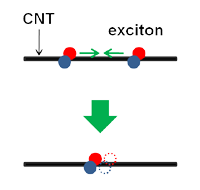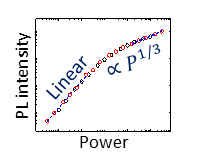Research:Exciton-exciton annihilation in air-suspended carbon nanotubes
Excitons in carbon nanotubes are very mobile and their diffusion lengths are long. This leads to highly efficient exciton-exciton annihilation processes, where an exciton is eliminated in a collision of two excitons. It is important to understand such a phenomenon, as it can influence light emission efficiencies as well as single photon emission processes.

We have experimentally investigated the power dependence of photoluminescence from air-suspended carbon nanotubes, and compared the results with Monte-Carlo simulations as well as analytic solutions of the diffusion equation. As the excitation power increases, exciton density becomes higher, resulting in more frequent exciton-exciton annihilation. As a consequence, photoluminescence intensity increases sublinearly with excitation power.

Interestingly, photoluminescence shows one-third power-law dependence. This implies that exciton-exciton annihilation rates are proportional to the cube of exciton density, different from the usual square power-law in two-body scattering processes. In carbon nanotubes, the one-dimensional motion of excitons forces them to result in head-on collisions, and therefore the scattering rates have an extra power in the density.
To learn more about this work, please refer to:
Exciton diffusion, end quenching, and exciton-exciton annihilation in individual air-suspended carbon nanotubes
Phys. Rev. B
91, 125427 (2015).
![]()